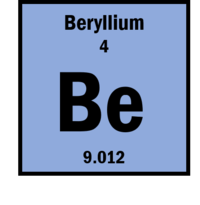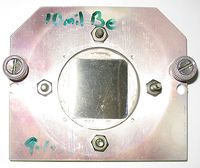Beryllium

Beryllium is the 4th element on the periodic table of elements, and is an alkaline earth element.[2] Some of its properties are listed below:[2]
| Atomic weight | 9.012 |
| Density (at 0oC) | 1.85 g/cm3 |
| Boiling point | 2741 K |
| Melting point | 1560 K |
Beryllium is an alkaline earth metal. It has low density and is silver-white in colour. It is found in multiple minerals, including beryl which has precious forms as emerald and aquamarine.[2]
Beryllium Uses

Beryllium is usually alloyed with copper or nickel to increase their thermal and electrical conductivity. These alloys are used to make items like gyroscopes, springs, electrical contacts, spot-welding electrodes, and non-sparking tools. Other alloys are used for aircraft, spacecraft, and satellites.[2] Beryllium alloys tend to be stiff, lightweight, and stable over a wide range of temperatures (due to its high melting point), making them ideal for aerial equipment.[4]
Beryllium foil is sometimes used in X-ray lithography. The foil is used as a "window" for the X-rays to take clear images of the item being inspected (Figure 2).[2]
Beryllium's high melting point makes it useful in nuclear reactors and other nuclear work. Beryllium can reflect neutrons (neutron reflector), which lets nuclear reactors have a more even distribution of neutrons.[4]
Isotopes
Beryllium has one isotope found in nature:[2]
| Symbol | Natural Abundance |
|---|---|
| 9Be | 100% |
Video
The video below is from the University of Nottingham's periodic videos project.[5] They have created a complete suite of short videos on every element on the periodic table of elements.
For Further Reading
- Periodic table of elements
- Metal
- Greenhouse effect
- Pollution
- Or explore a random page
References
- ↑ Made internally by a member of the Energy Education team, with information from periodictable.com, Available: http://periodictable.com/Elements/001/index.html
- ↑ 2.0 2.1 2.2 2.3 2.4 2.5 Royal Society of Chemistry Periodic Table, Beryllium [Online], Available: http://www.rsc.org/periodic-table/element/4/beryllium
- ↑ Wikimedia Commons, File:Beryl-130023.jpg [Online], Available: https://en.wikipedia.org/wiki/File:Beryl-130023.jpg
- ↑ 4.0 4.1 John Emsley, "Nature’s Building Blocks: An A-Z Guide to the Elements", Oxford University Press, New York, 2nd Edition, 2011.
- ↑ See more videos from the University of Nottingham on different elements here: http://www.periodicvideos.com/

